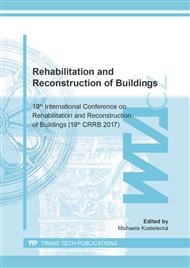[1]
P. Kuklík et a., Possibilities of more application of wooden multi-storey buildings as compared to multi-storey brick buildings, Forests of the Czech Republic, Hradec Králové (2017).
Google Scholar
[2]
Information on https://www.drevostavitel.cz.
Google Scholar
[3]
M. Böhm, Evaluating the influence of moisture content on the mechanical and physical properties of OSB, Dissertation thesis, (2008).
Google Scholar
[4]
O. Suchsland, Linear hygroscopic expansion of selected commercial particleboards, Forest Products Journal, 22 (1972).
Google Scholar
[5]
Q. Wu, O. Suchsland, Linear expansion and its relationship to moisture content change for commercial oriented strandboards. Forest Products Journal, 46 (1996) 76-83.
Google Scholar
[6]
Q. Wu, In-plane dimensional stability of oriented strand panel: effect of processing variables, Wood and Fiber Science, 31 (1999) 28-40.
Google Scholar
[7]
Q. Wu, Ch. Piao, Thickness swelling and its relationship to internal bond strength loss of commercial oriented strandboard, Forest Products Journal, 49 (1999).
Google Scholar
[8]
J. Kolb, Holtzbau mit System, third ed., Grada Publishing, a.s., Praha, (2011).
Google Scholar
[9]
I. Gabriel, Holtzfassaden, first ed., Grada Publishing, a.s., Praha, (2011).
Google Scholar
[10]
B. Šťastná, Ernst Wiesner: Budova Poštovního a telegrafního úřadu v Šumperku, Dissertation Thesis, Masaryk University, (2014).
Google Scholar
[11]
Information on http://www.cetris.cz.
Google Scholar
[12]
L. R. Gobakken, G. I. Vestol, Surface mould and blue stain fungi on coated Norway spruce cladding. International Biodeterioration and Biodegradation, (2012) 181-186.
DOI: 10.1016/j.ibiod.2012.10.001
Google Scholar
[13]
Information on http://www.secacz.cz.
Google Scholar
[14]
Information on https://www.agrop.cz.
Google Scholar
[15]
Information on https://www.nextwood.cz.
Google Scholar
[16]
Information on https://www.perwood.cz.
Google Scholar
[17]
Czech Standards Institute (1995), Adhesives. Wood based panels. Determination of dimensions of boards. Part 2: Determination of squareness and edge straightness (ČSN EN 324-2), Retrieved from http://csnonline.unmz.cz.
DOI: 10.3403/00299587u
Google Scholar
[18]
Czech Standards Institute (2012), Wood-based panels - Determination of dimensions of test pieces (ČSN EN 325), Retrieved from http://csnonline.unmz.cz.
Google Scholar
[19]
Czech Standards Institute (1999), Ceramic tiles - Part 10: Determination of moisture expansion (ČSN EN ISO 10545-10), Retrieved from http://csnonline.unmz.cz.
Google Scholar
[20]
Czech Standards Institute (1993), Plastics. Determination of coefficient of linear thermal expansion of plastics (ČSN 64 0528), Retrieved from http://csnonline.unmz.cz.
Google Scholar
[21]
Czech Standards Institute (2005), Plastics. Natural stone test methods - Determination of linear thermal expansion coefficient (ČSN EN 14581), Retrieved from http://csnonline.unmz.cz.
Google Scholar
[22]
B. Nečasová, P. Liška, M. Šimáčková and J. Šlanhof, Case Study on Determination of Tensile Properties of Construction Sealants at Variable Temperatures, Applied Mechanics and Materials 824 (2016) 18-26.
DOI: 10.4028/www.scientific.net/amm.824.18
Google Scholar
[23]
Information on https://ipocasi.cz.
Google Scholar


